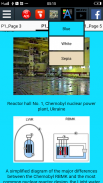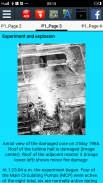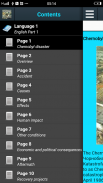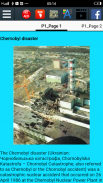








Chernobyl disaster History

คำอธิบายของChernobyl disaster History
The Chernobyl disaster, also referred to as the Chernobyl accident, was a catastrophic nuclear accident. It occurred on 25–26 April 1986 in the No. 4 light water graphite moderated reactor at the Chernobyl Nuclear Power Plant near the now-abandoned town of Pripyat, in northern Ukrainian Soviet Socialist Republic, Soviet Union, approximately 104 km (65 mi) north of Kiev.[2]
The event occurred during a late-night safety test which simulated a station blackout power-failure, in the course of which safety systems were intentionally turned off. A combination of inherent reactor design flaws and the reactor operators arranging the core in a manner contrary to the checklist for the test, eventually resulted in uncontrolled reaction conditions. Water flashed into steam generating a destructive steam explosion and a subsequent open-air graphite fire.[note 1] This fire produced considerable updrafts for about nine days. These lofted plumes of fission products into the atmosphere. The estimated radioactive inventory that was released during this very hot fire phase approximately equaled in magnitude the airborne fission products released in the initial destructive explosion.[3] This radioactive material precipitated onto parts of the western USSR and Europe.
During the accident, steam-blast effects caused two deaths within the facility; one immediately after the explosion, and the other, compounded by a lethal dose of radiation. Over the coming days and weeks, 134 servicemen were hospitalized with acute radiation sickness(ARS), of which 28 firemen and employees died in the days-to-months afterward from the radiation effects.[4] In addition, approximately fourteen radiation induced cancer deaths among this group of 134 hospitalized survivors, were to follow within the next ten years (1996).[5] Among the wider population, an excess of 15 childhood thyroid cancer deaths were documented as of 2011.[1][6] It will take further time and investigation to definitively determine the elevated relative risk of cancer among the surviving employees, those that were initially hospitalized with ARS and the population at large.[7]
This app is about history and for research Purpose .
ภัยพิบัติที่เชอร์โนบิลเรียกว่าอุบัติเหตุเชอร์โนบิลเป็นอุบัติเหตุนิวเคลียร์ที่รุนแรง มันเกิดขึ้นเมื่อวันที่ 25-26 เมษายน 2529 ในโรงไฟฟ้านิวเคลียร์กราไฟท์แบบเบา 4 แห่งที่โรงไฟฟ้านิวเคลียร์เชอร์โนบิลใกล้เมือง Pripyat ซึ่งเป็นเมืองร้างทางตอนเหนือของสาธารณรัฐสังคมนิยมโซเวียตยูเครนยูเครนสหภาพโซเวียตประมาณ 104 กม. (65 ไมล์) ทางเหนือของเคียฟ [2]
เหตุการณ์เกิดขึ้นระหว่างการทดสอบความปลอดภัยในช่วงดึกซึ่งจำลองสถานีดับไฟดับในช่วงที่ระบบความปลอดภัยถูกปิดโดยเจตนา การรวมกันของข้อบกพร่องในการออกแบบเครื่องปฏิกรณ์โดยธรรมชาติและตัวดำเนินการของเครื่องปฏิกรณ์ที่จัดเรียงแกนกลางในลักษณะที่ตรงกันข้ามกับรายการตรวจสอบสำหรับการทดสอบในที่สุดก็ส่งผลให้เกิดสภาวะที่ไม่สามารถควบคุมได้ น้ำที่พุ่งเข้าไปในไอน้ำจะก่อให้เกิดการระเบิดของไอน้ำที่เป็นอันตรายและต่อมาเป็นกราไฟท์แบบเปิดโล่ง [note 1] ไฟนี้ผลิตกระแสไฟฟ้าจำนวนมากประมาณเก้าวัน ผลิตภัณฑ์ฟิชชันที่ lofted เหล่านี้ขึ้นสู่ชั้นบรรยากาศ สินค้าคงคลังของสารกัมมันตรังสีโดยประมาณที่ถูกปล่อยออกมาในช่วงที่เกิดเพลิงไหม้ร้อนจัดนี้มีขนาดเท่ากับผลิตภัณฑ์ฟิชชันในอากาศที่ปล่อยออกมาในการระเบิดครั้งแรก [3] สารกัมมันตภาพรังสีนี้ตกตะกอนเป็นส่วนหนึ่งของสหภาพโซเวียตและยุโรปตะวันตก
ในช่วงที่เกิดอุบัติเหตุผลกระทบจากแรงระเบิดทำให้เกิดการเสียชีวิตสองครั้งภายในโรงงาน หนึ่งทันทีหลังจากการระเบิดและอื่น ๆ ประกอบกับปริมาณรังสีที่อันตรายถึงชีวิต ในช่วงไม่กี่วันที่ผ่านมามีผู้ใช้บริการ 134 นายที่เข้ารับการรักษาในโรงพยาบาลด้วยอาการป่วยจากการแผ่รังสีเฉียบพลัน (ARS) ซึ่งพนักงานดับเพลิงและพนักงาน 28 คนเสียชีวิตในวันต่อเดือนจากผลของรังสี [4] นอกจากนี้มีผู้เสียชีวิตจากมะเร็งที่เข้ารับการรักษาในโรงพยาบาลจำนวน 134 คนที่เสียชีวิตจากการฉายรังสีประมาณสิบสี่คนซึ่งจะต้องติดตามภายในสิบปีถัดไป (1996) [5] ในกลุ่มประชากรที่กว้างกว่านั้นมีรายงานการเสียชีวิตของมะเร็งต่อมไทรอยด์เกินกว่า 15 คนในปี 2011 [1] [6] มันจะต้องใช้เวลามากขึ้นและการตรวจสอบเพื่อกำหนดความเสี่ยงที่สูงขึ้นของโรคมะเร็งในหมู่พนักงานที่รอดชีวิตอย่างแน่นอนซึ่งเป็นคนแรกที่เข้ารับการรักษาในโรงพยาบาลด้วย ARS และประชากรที่มีขนาดใหญ่ [7]
แอพนี้เป็นเรื่องเกี่ยวกับประวัติและเพื่อการวิจัย

























